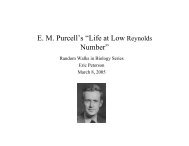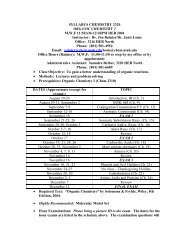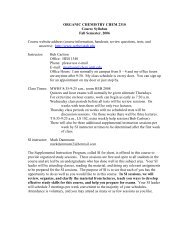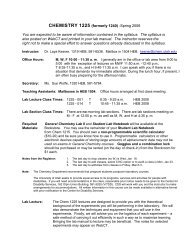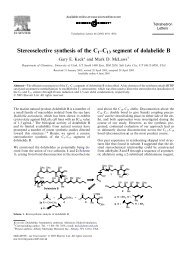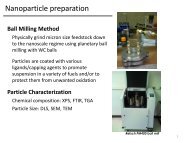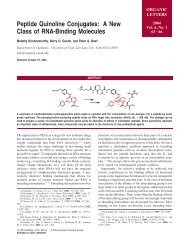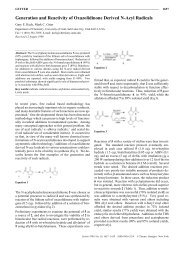Mitsunobu reactions of nucleoside analogs using ... - UC Davis
Mitsunobu reactions of nucleoside analogs using ... - UC Davis
Mitsunobu reactions of nucleoside analogs using ... - UC Davis
You also want an ePaper? Increase the reach of your titles
YUMPU automatically turns print PDFs into web optimized ePapers that Google loves.
Tetrahedron Letters 47 (2006) 3153–3156<br />
<strong>Mitsunobu</strong> <strong>reactions</strong> <strong>of</strong> <strong>nucleoside</strong> <strong>analogs</strong> <strong>using</strong><br />
triisopropyl phosphite–DIAD<br />
Eduardo A. Véliz and Peter A. Beal *<br />
Department <strong>of</strong> Chemistry, University <strong>of</strong> Utah, Salt Lake City, Utah 84112, USA<br />
Received 1 January 2006; revised 21 February 2006; accepted 23 February 2006<br />
Available online 10 March 2006<br />
Abstract—Herein, we report the use <strong>of</strong> triisopropyl phosphite (TIP) as an effective substitute for triphenylphosphine in the <strong>Mitsunobu</strong><br />
reaction <strong>of</strong> <strong>nucleoside</strong> <strong>analogs</strong>. In addition, the use <strong>of</strong> triphenyl phosphite as an alternative reagent for the expensive hexamethylphosphorous<br />
triamide (HMPT) in the Véliz–Beal bromination protocol is reported.<br />
Ó 2006 Elsevier Ltd. All rights reserved.<br />
The <strong>Mitsunobu</strong> reaction has found wide spread use in<br />
many fields because <strong>of</strong> its high reliability and extensive<br />
applicability. 1–3 However, the generation <strong>of</strong> phosphine<br />
oxide and hydrazinodicarboxylate as by-products <strong>of</strong>ten<br />
prevents the desired product from being isolated. Various<br />
ways <strong>of</strong> addressing this problem have been developed<br />
including triphenylphosphine (TPP) analogues<br />
that can be either removed by acid wash 4,5 or anchored<br />
to a resin. 6 The latter has also been applied to derivatives<br />
<strong>of</strong> dialkyl azodicarboxylates. 7 A new method that<br />
removes impurities via the novel ring opening metathesis<br />
(ROM) protocol has been developed by Barrett and<br />
Schröder. 8 Alkyl phosphines have also been introduced<br />
as a replacement for TPP. However, these compounds<br />
are highly expensive or pyrophoric. Palladium-catalyzed<br />
cross-coupling <strong>reactions</strong> are another example where significant<br />
amounts <strong>of</strong> expensive basic phosphine ligands<br />
are used. Because <strong>of</strong> this, organic chemists have demonstrated<br />
the ability <strong>of</strong> phosphites in combination with different<br />
types <strong>of</strong> palladium species as productive<br />
catalysts. 9–11 Here we describe the use <strong>of</strong> phosphites in<br />
<strong>Mitsunobu</strong> <strong>reactions</strong> yielding <strong>nucleoside</strong> <strong>analogs</strong>.<br />
Maruyama et al. found that N 2 -alkyl-6-chloropurine<br />
ribo<strong>nucleoside</strong> derivatives can be synthesized via a<br />
<strong>Mitsunobu</strong> reaction from 6-chloro-2-acetamido-purine<br />
ribo<strong>nucleoside</strong>. 12 However, the product was difficult to<br />
purify from the <strong>Mitsunobu</strong> by-products. These results<br />
and the significant outcome that phosphites can be used<br />
Keywords: Nucleoside <strong>analogs</strong>; <strong>Mitsunobu</strong> reaction; Phosphites.<br />
* Corresponding author. Tel.: +1 801 585 9719; e-mail: beal@<br />
chemistry.chem.utah.edu<br />
as a substitute <strong>of</strong> phosphines in palladium cross couplings<br />
prompted us to explore further the application<br />
<strong>of</strong> our substrate 6-bromo-2-acetamidopurine ribo<strong>nucleoside</strong><br />
and develop a new reagent system for the <strong>Mitsunobu</strong><br />
reaction lacking the by-product problems. The use<br />
<strong>of</strong> phosphites would generate phosphates, which are<br />
more water soluble than their counterpart phosphine<br />
oxides. Morrison, 13 and later, <strong>Mitsunobu</strong> et al. 14 found<br />
that alkyl phosphites react with diethyl azodicarboxylate<br />
(DEAD). However, the intermediate suffered an intramolecular<br />
Arbuzov rearrangement. These results were<br />
used as the concept to develop our modified <strong>Mitsunobu</strong><br />
reaction. If we blocked the intramolecular Arbuzov<br />
rearrangement by <strong>using</strong> a sterically hindered alkyl<br />
group, phosphites might be effective in the process. We<br />
found that triisopropyl phosphite (TIP) was an effective<br />
substitute for TPP in the <strong>Mitsunobu</strong> reaction. In addition,<br />
the use <strong>of</strong> triphenyl phosphite as an alternative reagent<br />
for the expensive hexamethylphosphorous<br />
triamide (HMPT) in our bromination protocol is also<br />
reported.<br />
We have shown in our laboratories the unusually high<br />
reactivity <strong>of</strong> 6-bromo-2-acetamidopurine triacetyl ribo<strong>nucleoside</strong><br />
(1) toward nucleophiles. 15 To ensure the survival<br />
<strong>of</strong> this compound under the <strong>Mitsunobu</strong> conditions,<br />
we submitted the substrate to standard reaction conditions.<br />
Hence, we treated 1 with benzyl alcohol in the<br />
presence <strong>of</strong> TPP and DEAD in THF for 24 h. This reaction<br />
worked well to give the product in 89% yield after<br />
purification (Scheme 1).<br />
We then used a phosphite in this reaction that would not<br />
suffer the Arbuzov rearrangement. For this purpose, we<br />
0040-4039/$ - see front matter Ó 2006 Elsevier Ltd. All rights reserved.<br />
doi:10.1016/j.tetlet.2006.02.138
3154 E. A. Véliz, P. A. Beal / Tetrahedron Letters 47 (2006) 3153–3156<br />
Scheme 1.<br />
initially chose triphenyl phosphite. However, no product<br />
was obtained. We reasoned that a more nucleophilic,<br />
but sterically hindered, phosphite might be needed,<br />
and repeated the reaction <strong>using</strong> triisopropyl phosphite<br />
(TIP). As a model system, substrate 1 was allowed to<br />
react with a series <strong>of</strong> alcohols under <strong>Mitsunobu</strong> conditions<br />
(Table 1). 20 Data presented in Table 1 indicate that<br />
activated alcohols gave good to excellent yields <strong>using</strong><br />
DEAD or DIAD in THF or dioxane as solvents at<br />
50 °C (entries 1–4, and 7). Increasing the steric hindrance<br />
at the ortho position did not affect the reactivity<br />
<strong>of</strong> the alcohol (entries 2 and 3). However, unactivated<br />
alcohols and more hindered activated alcohols (entries<br />
5, 9, and 10) did not form the desired product.<br />
Next, we studied different combinations <strong>of</strong> azodicarboxylate<br />
reagent/solvent for the optimization <strong>of</strong> the reaction<br />
conditions. Consequently, 4-trifluoromethylbenzyl<br />
alcohol was allowed to react under different conditions<br />
according to Table 2. We found that DEAD or DIAD<br />
in THF were the best combinations for this reaction.<br />
The new reagent N,N,N 0 ,N 0 -tetramethylazodicarboxamide<br />
(TMAD), which was developed to be used with<br />
weak acids, gave traces <strong>of</strong> the desired product. 16–18<br />
In addition to the use <strong>of</strong> phosphites in the <strong>Mitsunobu</strong><br />
reaction, we explored the utility <strong>of</strong> this type <strong>of</strong> reagent<br />
in the Véliz–Beal bromination procedure. 15,19 Our protocol<br />
calls for the use <strong>of</strong> hexamethylphosphorous triamide<br />
(HMPT), which is an expensive reagent and has<br />
precluded the use <strong>of</strong> this procedure on large scales. We<br />
found that substituting HMPT for triphenyl phosphite<br />
gave the desired bromo derivative in 76–82% yield<br />
(Scheme 2). However, the reaction took longer to go<br />
to completion (5 h instead <strong>of</strong> 1.5 h) and 5 equiv <strong>of</strong> triphenyl<br />
phosphite were needed instead <strong>of</strong> 2 equiv <strong>of</strong><br />
HMPT. To our surprise, no product was observed when<br />
the 2-acetamido derivative was used.<br />
In conclusion, we have demonstrated the use <strong>of</strong> triisopropyl<br />
phosphite in the <strong>Mitsunobu</strong> reaction as an alternative<br />
to phosphine reagents. Activated alcohols reacted<br />
well and DIAD/THF or DEAD/THF gave the best<br />
results as reagent systems. The formation <strong>of</strong> phosphate<br />
as by-product simplifies its purification due to its higher<br />
solubility in water. More experiments are being<br />
conducted in our laboratories to further study the<br />
scope <strong>of</strong> this reagent system and will be published in<br />
due time.<br />
Table 1.<br />
R Azo derivative Solvent Time (h) Yield (%)<br />
Benzyl DIAD Dioxane 5 95<br />
2-BrBn DIAD Dioxane 18 97<br />
2-BrBn DEAD THF 24 97<br />
p-CF 3 -Bn DIAD THF 24 95<br />
1-Ph–ethanol DIAD Dioxane 24 NR<br />
DIAD Dioxane 24 NR<br />
DIAD THF 24 85<br />
DTAD Dioxane 24 Incomplete<br />
DIAD THF 24 NR<br />
2-Butanol DIAD Dioxane 5 NR<br />
Ref. 20.
E. A. Véliz, P. A. Beal / Tetrahedron Letters 47 (2006) 3153–3156 3155<br />
Table 2.<br />
Azo derivative Solvent Yield (%)<br />
DIAD Dioxane Separation problems<br />
DEAD Dioxane Traces<br />
TMAD Dioxane Traces<br />
DEAD THF 90<br />
DIAD THF 95<br />
TMAD THF Traces<br />
Scheme 2.<br />
Acknowledgements<br />
This work was supported by a Grant from the National<br />
Institutes <strong>of</strong> Health (USA) to P.A.B. (GM57214).<br />
References and notes<br />
1. <strong>Mitsunobu</strong>, O.; Yamada, M. Bull. Chem. Soc. Jpn. 1967,<br />
40, 2380–2382.<br />
2. <strong>Mitsunobu</strong>, O. Synthesis 1981, 1–28.<br />
3. Hughes, D. L. Org. React. 1992, 42, 335–656.<br />
4. Camp, D.; Jenkins, I. D. Aust. J. Chem. 1988, 41, 1835–<br />
1839.<br />
5. von Itzstein, M.; Mocerino, M. Synth. Commun. 1990, 20,<br />
2049–2057.<br />
6. Amos, R. A.; Emblidge, R. W.; Havens, N. J. Org. Chem.<br />
1983, 48, 3598–3600.<br />
7. Arnold, L. D.; Assil, H. I.; Vederas, J. C. J. Am. Chem.<br />
Soc. 1989, 111, 3973–3976.<br />
8. Barrett, A. G. M.; Schröder, J. Org. Lett. 2000, 2, 2999–<br />
3001.<br />
9. Beller, M.; Zapf, A. Synlett 1998, 792–793.<br />
10. Zapf, A.; Beller, M. Chem. Eur. J. 2000, 6, 1830–1833.<br />
11. Kayaki, Y.; Koda, T.; Ikariya, T. Eur. J. Org. Chem. 2004,<br />
4989–4993.<br />
12. Maruyama, T.; Yorikane, A.; Kozai, S. Nucleosides,<br />
Nucleotides Nucleic Acids 2001, 20, 935–936.<br />
13. Morrison, D. C. J. Org. Chem. 1958, 23, 1072–1074.<br />
14. <strong>Mitsunobu</strong>, O.; Yamada, M.; Mukaiyama, T. Bull. Chem.<br />
Soc. Jpn. 1967, 40, 935–939.<br />
15. Véliz, E. A.; Beal, P. A. J. Org. Chem. 2001, 66, 8592–<br />
8598.<br />
16. Tsunoda, T.; Yamamiya, Y.; Itô, S. Tetrahedron Lett.<br />
1993, 34, 1639–1642.<br />
17. Tsunoda, T.; Nagaku, M.; Nagino, C.; Kawamura, Y.;<br />
Ozaki, F.; Hioki, H.; Itô, S.Tetrahedron Lett. 1995, 36,<br />
2531–2534.<br />
18. Itô, S.; Tsunoda, T. Pure Appl. Chem. 1999, 71, 1053–<br />
1057.<br />
19. Véliz, E. A.; Beal, P. A. Tetrahedron Lett. 2000, 41, 1695–<br />
1697.<br />
20. Typical procedure: To a solution <strong>of</strong> the 6-bromo tetraacetyl<br />
purine derivative (50 mg, 0.097 mmol) in dry solvent<br />
(7 mL) (see Table 1) was added sequentially the alcohol<br />
(3.0 equiv, 0.292 mmol), triisopropyl phosphite (60.6 mg,<br />
0.292 mmol), and the azodicarboxylate derivative<br />
(3.0 equiv, 0.292 mmol). The reaction mixture was stirred<br />
at 50 °C and followed by thin layer chromatography.<br />
After completion, the mixture was concentrated and<br />
redissolved in EtOAc (15 mL). The organic solution was<br />
successively washed with water (1 · 15 mL) and brine<br />
(1 · 15 mL), and then concentrated under reduced pressure.<br />
The syrup obtained was purified by flash column<br />
chromatography (2% MeOH/CHCl 3 ) to afford the N 2 -<br />
alkylated derivative. Yields are reported for compounds<br />
that appeared homogenous by thin layer chromatography<br />
and 1 H NMR. All products gave satisfactory spectral data<br />
( 1 H and 13 C NMR, MS, and HRESMS). 6-Bromo-2-(N-2-<br />
bromobenzyl)acetamido-(2,3,5-tri-O-acetyl-b-D-rib<strong>of</strong>uranosyl)purine.<br />
1 H NMR (CDCl 3 , 500 MHz): d (ppm) 8.22 (s,<br />
1H), 7.49 (d, J = 8.0 Hz, 1H), 7.19–7.17 (m, 2H), 7.06–<br />
7.03 (m, 1H), 6.11 (d, J = 5.0 Hz, 1H), 5.73 (app. t,<br />
J = 5.5 Hz, 1H), 5.41 (d, J = 7.0 Hz, 2H), 5.37 (app. t,<br />
J = 5.0 Hz, 1H), 4.42 (app. q, J = 5.0 Hz, 1H), 4.31 (dd,<br />
J = 12.0, 3.0 Hz, 1H), 4.22 (dd, J = 12.5, 4.5 Hz, 1H), 2.59<br />
(s, 3H), 2.14 (s, 3H), 2.10 (s, 3H), 2.02 (s, 3H). 13 C NMR<br />
(CDCl 3 , 125 MHz): d (ppm) 172.0, 170.1, 169.4, 169.1,<br />
155.0, 150.6, 143.1, 142.8, 136.5, 132.6, 131.5, 128.4, 127.8,<br />
127.5, 122.6, 86.4, 80.1, 73.1, 70.2, 62.8, 50.2, 25.5, 20.7,<br />
20.5, 20.3. HRCIMS: calcd for C 25 H 25 Br 2 N 5 O 8 (M + )
3156 E. A. Véliz, P. A. Beal / Tetrahedron Letters 47 (2006) 3153–3156<br />
681.0070, obsd 681.0062. 6-Bromo-2-(N-allyl)acetamido-<br />
(2,3,5-tri-O-acetyl-b-D-rib<strong>of</strong>uranosyl)purine.<br />
1 H NMR<br />
(CDCl 3 , 500 MHz): d (ppm) 8.23 (s, 1H), 6.11 (d, J =<br />
4.5 Hz, 1H), 5.86 (app. t, J = 5.0 Hz, 1H), 5.50 (app. t,<br />
J = 5.0 Hz, 1H), 5.17 (dq, J = 17, 1.5 Hz, 1H), 5.08 (dq,<br />
J = 10, 1.5 Hz, 1H), 4.75 (app. d, J = 5.5 Hz, 2H), 4.48–<br />
4.45 (m, 1H), 4.40 (dd, J = 12.5, 3.5 Hz, 1H), 4.34 (dd,<br />
J = 12.5, 4.5 Hz, 1H), 2.48 (s, 3H), 2.14 (s, 3H), 2.11 (s,<br />
3H), 2.09 (s, 3H). 13 C NMR (CDCl 3 , 125 MHz): d (ppm)<br />
171.6, 170.1, 169.5, 169.2, 155.2, 150.5, 143.1, 142.8, 133.2,<br />
131.5, 116.8, 86.9, 80.1, 73.1, 70.0, 62.7, 48.8, 25.5, 20.7,<br />
20.4, 20.3. HRCIMS: calcd for C 21 H 25 BrN 5 O 8 (M+H) +<br />
554.0887, obsd 554.0885. 6-Bromo-2-(N-p-trifluoromethyl-<br />
benzyl)acetamido-(2,3,5-tri-O-acetyl-b-D-rib<strong>of</strong>uranosyl)-<br />
purine. 1 H NMR (CDCl 3 , 500 MHz): d ppm) 8.22 (s, 1H),<br />
7.52 (d, J = 8.5 Hz, 2H), 7.46 (d, J = 7.5 Hz, 2H), 6.06 (d,<br />
J = 4.0 Hz, 1H), 5.82 (app. t, J = 5.0 Hz, 1H), 5.41–5.39<br />
(m, 2H), 4.45–4.42 (m, 1H), 4.30 (dd, J = 12.5, 3.0 Hz,<br />
1H), 4.24 (dd, J = 12.5, 4.5 Hz, 1H), 2.56 (s, 3H), 2.14 (s,<br />
3H), 2.09 (s, 3H), 2.05 (s, 3H).<br />
13 C NMR (CDCl 3 ,<br />
125 MHz): d (ppm) 172.0, 170.1, 169.4, 169.1, 155.0, 150.5,<br />
143.3, 143.0, 141.9, 131.7, 129.3 (q, 2 J = 31.75 Hz), 127.9,<br />
124.1 (q, J = 270.1 Hz), 125.3 (q, 3 J = 3.75 Hz), 86.9, 79.9,<br />
73.0, 69.9, 62.6, 49.4, 25.6, 20.6, 20.4, 20.2. HRCIMS:<br />
calcd for C 26 H 26 BrF 3 N 5 O 8 (M+H) + 672.0918, obsd<br />
672.0955.



